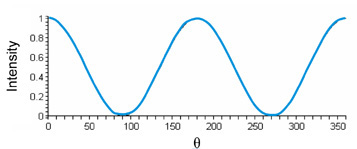Optipedia • SPIE Press books opened for your reference.
Malus's Law
Excerpt from Field Guide to Polarization
At the beginning of the nineteenth century the only known way to generate polarized light was with a calcite crystal. In 1808, using a calcite crystal, Malus discovered that natural incident light became polarized when it wasreflected by a glass surface, and that the light reflected close to an angle of incidence of 57° could be extinguished when viewed through the crystal. He then proposed that natural light consisted of the s- and p-polarizations, which were perpendicular to each other.

Since the intensity of the reflected light varied from a maximum to a minimum as the crystal was rotated, Malus proposed that the amplitude of the reflected beammust be A = A0 cosθ. However, in order to obtain the intensity, Malus squared the amplitude relation so that the intensity equation I(θ) of the reflected polarized light was

where I0 = A02. this equation is known as Malus’s Law. A normalized plot of Malus’s Law is shown below.

E. Collett, Field Guide to Polarization, SPIE Press, Bellingham, WA (2005).
View SPIE terms of use.

